Your Planets
Portraits of the Planets
Aspects between Planets
The planetary ages
The planetary families
Planets in Signs
The Planets in comics


Astrology was born in Chaldea, on the banks of the Tigris and Euphrates, about 5000 years ago. However, Babylonian astrology totally ignored the doctrine of the 4 Elements. The latter were, in a way, “grafted” onto the body of Mesopotamian knowledge only around the 3rd century BC, when the encounter between the Greek worldview and Babylonian knowledge occurred.
In this sense, the Elemental doctrine is absolutely not consubstantial with the original astrological thought. This historical fact is not, in itself, I gladly grant you, an argument for distrusting it, reforming it or rejecting it. After all, the elements of Freudian psychoanalysis that astrologer A. Barbault himself grafted onto traditional astrological theories (1) were unknown and unimaginable to the Greeks as well as the Babylonians. The same goes for Dane Rudhyar and humanistic astrology, which attempted to synthesize ancient astrological doctrines and the concepts of Carl-Gustav Jung (2). And this is even more true with regard to the conditionalist astrology developed by J.-P. Nicola: the radically modern and original reformulation that he undertook through the R.E.T., the Theory of Ages and the reflexological and photoperiodic zodiacs was unthinkable for our Chaldean ancestors.
All knowledge is brought to enrich and become more complex with the passage of time and the progress of knowledge. Astrology is no exception to this law of evolution, no offense to those who believe that it appeared all at once, perfect and complete for eternity.
That said, each era, each culture produces its paradigms, its grids for reading reality. Translation: we have the knowledge that we can according to the place and the time where we live. For a doctor, an astrologer or a Greek philosopher of the great Hellenistic period, the doctrine of the four Elements and its internal organization based on Cold-Hot-Dry-Humid, offered intelligence and observation a concrete conceptual framework. and structured to describe and think about sensible realities, the phenomenal world.
It is probably Empedocles (−490/−420) who first imagined the doctrine of the 4 Elements. Which allowed Hippocrates (−460/−377) to define his 4 “Seasonal temperaments” (Choleric-Melancholic-Sanguine-Phlegmatic). Later and following him, Aristotle (−384/−322) finally theorized the nature of the Elements by combining the concepts of hot, cold, dry and humid. A little before or approximately at the same time, Berossus (around −320 according to current historical knowledge) introduced Babylonian astrology into the body of classical Greek knowledge.

From the middle of 2nd century BC, Greek astronomers, physicians, physicists and philosophers mostly think of the world through these Elemental categories. And it was probably at this time that the fusion took place between, on the one hand, the primitive Babylonian zodiac and the Elemental doctrine, and on the other hand, the identification of the Chaldean planet-gods with the gods of the Greek pantheon.
If we stick to the vision of the physical world, still relatively simple and undeveloped, which reigned at that time, the doctrine of the 4 Elements then seems full of meaning and common sense: we actually need Fire to to warm us, Air to breathe, Earth to nourish us and Water to give birth to us and water us. Outside of these 4 physical elements, no salvation?
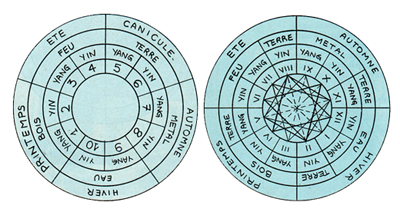 That’s not what the Chinese think. For a very long time, even before the Greeks, they developed another Elemental doctrine consisting of 5 “officers”: Fire, Earth, Metal, Wood and Water. The Chinese therefore did not consider it useful to add the Air Element, although it is physically essential for survival. Did they miss it to the point of suffocation? Did they breathe, in these distant lands populated by “strange strangers”, Metal or Wood?
That’s not what the Chinese think. For a very long time, even before the Greeks, they developed another Elemental doctrine consisting of 5 “officers”: Fire, Earth, Metal, Wood and Water. The Chinese therefore did not consider it useful to add the Air Element, although it is physically essential for survival. Did they miss it to the point of suffocation? Did they breathe, in these distant lands populated by “strange strangers”, Metal or Wood?
Thus, at least two Elemental doctrines, conceived and imagined by two of the greatest civilizations, are they in competition to describe the real. A priori, there is nothing to confirm that one of the two theories is “more true” or “better” that the other. However, each can legitimately claim universality, from the point of view of the internal logic of its vision of the world.
To possibly decide between them, only the confrontation of this internal logic of the theory with the logic in itself of the observed phenomena is adequate. In other words: it is experimentation that makes it possible to determine which theory most faithfully describes and predicts objective realities.
What would have happened to the Elemental doctrine applied to astrology, and more specifically to the zodiac, if the Greeks had adopted the Chinese system? There would certainly be no triplicity of Air. But then, what becomes of Gemini, Libra and Aquarius? Are they wood or metal? Finally, knowing that the 12 Greek Elemental Signs are obtained by multiplying the 4 Elements by 3, how many Signs would we have with 5 Elements? 10? 15?
It has been several centuries since any doctor, astronomer, philosopher or serious physicist has referred to the doctrine of the 4 Elements to describe and think about reality.
On the level of pure physics, the atomistic and even sub-atomic conception has imposed itself and has demonstrated its effectiveness in understanding animate and inanimate matter. Biologically, these same atoms organize themselves into molecules. And the incredible progress that medicine has experienced in a few years thanks to molecular biology demonstrates very well to what extent this vision of the world is legitimate and justified by experimentation. In this area, only masochists or candidates for suicide today would agree to be treated by Galen (130/200 AD), apostle of medicine “Temperamental” and “elemental” Hippocratic, whose methods prevailed until the end of the Middle Ages, with the disastrous results that we know.
In short, anyone informed of current knowledge knows that reality is not made of 4 Elements, but of a multitude of sub-atomic particles which are organized into atoms, which by inter-organizing give birth to molecules, etc., each of these different levels of reality having its own structures.
Similarly, the works and discoveries of depth psychology, from the second half of the 19th century, have profoundly changed our conception of Man and his functioning. The Hippocratic “Temperaments” only allow it to be described in a simplistic and caricatural way. C. G. Jung understood this well, he who, the first for a very long time, undertook to reformulate a psychological typology based on quaternaries (Sensation-Feeling-Thought-Intuition) more subtle, more dialectical and, in a word, more complex than those of Hippocrates.
Everyone knows today that Man is not made of Fire, Earth, Air or Water, and that his psycho-physiological constitution cannot be exhaustively described in terms of hot-cold-dry-humid. And you don’t have to be a fanatic anti-astrology astronomer to point your telescope in the direction of the Sign of Taurus, and discover that the 30° ecliptic that defines it is not made of Earth. Johannes Kepler, astronomer-astrologer (1572–1630) was the first to categorically reject the doctrine of the Elements applied to the zodiac: “For me, for ten years I have completely rejected the division into twelve equal signs, the houses, the dominions, the triplicities”, he writes in his Harmonia Mundi.
Following Kepler, many astrologers now believe that the doctrine of the 4 Elements, which for centuries was the foundation of astrology, is now outdated. Physicists, astronomers, philosophers and doctors have abandoned it since the Renaissance, objectively noting its low descriptive and predictive power. Why should astrologers be the only ones to maintain it?
Only one argument can justify this position. The one that “the scientific study of the observable connection between celestial phenomena and more or less characterized changes in the life of groups or individuals” (2) is not within the purview of astrology, which “should be considered a great myth capable of inspiring and fostering great psycho-spiritual realizations” (2).
Indeed, if astrology is never just a myth, like Santa Claus, why not decorate it with the ancient 4 Elements? This gives him a beautiful white beard and a basket filled with symbolic gifts… But it is to despise, and astrology, and generations of astrologer-researchers, to reduce astrology to a fairy tale. Astrology is not a myth, it is an ignored science that describes the relationship between Man and the solar system to which he belongs.
The vast majority of astrologers therefore continue to practice… elementary astrology. One of the most famous of them, André Barbault (3), thus justifies this adherence to the doctrine of the elements: “I believe all the more… in the category of the elements because it is precisely the values of the four Hippocratic Temperaments that account for — above all! — Gauquelin’s statistical balance sheets. There is a stubborn truth at work here. Such is my realism.”
Remember that Michael Gauquelin, a psychologist by training, undertook, during the 1950s, to demonstrate with the help of statistics that astrology was only a speech without reality (4). Without succeeding: in fact, to his great surprise, his statistics highlighted the effects on the human being of five stars: Moon, Mars, Jupiter, Saturn and perhaps, according to him, Venus. In short, according to Gauquelin, only four planets out of the ten used by astrologers would have a real influence; moreover, his statistical studies did not reveal any zodiac effect.
But let’s move on… When A. Barbault refers to Gauquelin’s statistical report, it is for a simple reason: only four stars in the solar system seem to have a certain influence on the individual… and precisely, there are four Elements and Temperaments. But traditional astrology assigns an Elemental quality to each planet (5)… wouldn’t there be an analog eel under the rock?
If we are not too demanding and rigorous in terms of definitions, we can indeed consider that the lunar “type” is analogous to the “Phlegmatic” one, the marsian one to the “Choleric” one, the jupiterian one to the “Sanguine” one, and the saturnian one to the “Melancholic” one. But Gauquelin’s research having nevertheless highlighted the probable statistical existence of a “type” venusian, in which category should the latter be placed? According to A. Barbault, it would be a mixed type, “Sanguine-Phlegmatic”. And to say that with the five chinese elements, everything would be so much simpler: five statistical planets, five Elements…
If we accept that there is an analogy between the Hippocratic Temperaments (and by extension with the Elements) and the planetary functions, it is essential to demonstrate the same rigor as Hippocrates and Aristotle in dealing with this phenomenon. In this, to each type “pure” and to each type “mixed” should correspond to a planetary function.
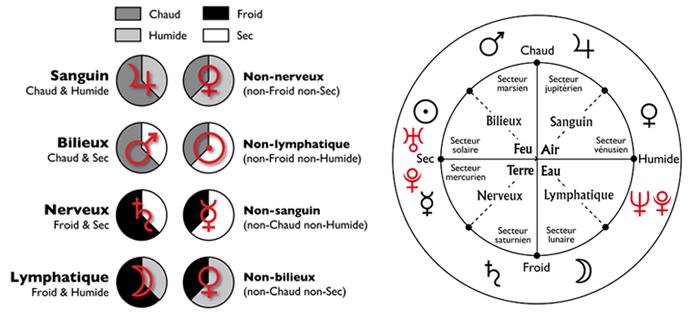
The diagram above on the left represents the astro-Hippocratic analogies proposed by André Barbault, a great specialist in Elemental astrology: the Choleric and the Melancholic are each represented by two planets. Why should the Sanguine and the Phlegmatic not be entitled to the same number? In the internal analog of this system, it is the least that can be demanded. But then, where to classify the last two planets? Indeed, in all Temperamental-Elemental rigor, the planetary functions not falling under a pure “Temperament” should be distributed within the 6 mixed “types” of the table below.
If Sun and Mercury (to which Gauquelin does not recognize any astrological influence) are, according to Barbault, “kinds” pure, there are five mixed types left to be divided between three planets (Uranus-Neptune-Pluto). Assuming that a finer analysis makes it possible to conclude that Sun and Mercury belong to these mixed types, the ten planets would correspond to 4 Pure Temperaments and 6 Mixed Temperaments. Everything would then be for the best in the best of Hippocratic worlds… except that classifying each planet in the Temperamentalo-Elemental box is not a cakewalk. It is probably for this reason that A. Barbault gives up, in his Traité pratique d’astrologie, the Hippocratic typology in favor of the categories of Le Senne when it comes to defining the characterological profile of the three most distant planets. Thus would Uranus be a “Passionate (Emotional-Active-Secondary)”, Neptune one “Under-Active Emotional”, while Pluto is not entitled to any rubric “characterology”, which is strange to say the least… Could this be unacknowledged and unacknowledged proof that the system of Elements and Temperaments does not really apply to planetary functions?
 The matter becomes even more complicated if we take into account the Rulerships that the planets would exert on the Signs:
The matter becomes even more complicated if we take into account the Rulerships that the planets would exert on the Signs:
▶
The Sun (Fire) rules Leo and Aries (Fire).
▶
The Moon (Water) rules Cancer (Water) and Taurus (Earth).
▶
Mercury (Melancholic according to Barbault, therefore Earth) masters Gemini (Air) and Virgo (Earth).
▶
Venus (Air-Water, since Sanguine-Phlegmatic according to Barbault) masters Taurus (Earth) and Libra (Air).
▶
Mars (Fire) rules Aries (Fire) and Scorpio (Water).
▶
Jupiter (Air, since Sanguine) masters Sagittarius (Fire) and Pisces (Water).
▶
Saturn (Earth) rules Capricorn (Earth), Libra and Aquarius (Air).
▶
Uranus (Fire?) masters Aquarius (Air); Neptune (Water?) dominates Pisces (Water); and Pluto (???) rules Scorpio (Water) and Aries (Fire).
It only sticks for the Sun and, if necessary, for Neptune. All other masteries produce, to varying degrees, aberrant logical results. Absolute record holder: Jupiter. This planet “Air-Sanguine” does not control any Air Sign, which is still a shame! Moreover, it would be logical to advance that the planets which govern two Signs, therefore two Elements-Temperaments, should be “kinds” Mixed Elementals. This is not the case for most of them.
These few thoughts on the Masteries naturally lead us to consider the application of the Elements to the Signs of the zodiac. In traditional astrology, each season has an Elemental quality:
▶ Spring, humid and warm, belongs to the Air Element (Sanguine Temperament).
▶ Summer, hot and dry, belongs to the Fire Element (Choleric Temperament).
▶ Autumn, cold and dry, belongs to the Earth Element (Melancholic Temperament).
▶ Winter, cold and humid, belongs to the Water Element (Phlegmatic Temperament).
We will notice first of all that autumn, the season of “Nerve-Earth”, has absolutely no Earth Sign. What to make a bit… “Melancholic” logical minds! Thus, according to A. Barbault, Libra would be “built on the balance of two opposing temperaments: a Melancholic (Saturn)… and a Sanguine (Venus)”. Let us note in passing that Venus has lost in history her half of Phlegmatic Temperament. On the other hand, the Master of this Air Sign, therefore Sanguine, is a Sanguine planet. It’s always that.
Things go wrong with Scorpio. This Water Sign should in all Hippocratic logic be a Phlegmatic. But according to A. Barbault, he would have a “Choleric temperament”. Therefore a nature of Fire, without any relation to the Season to which it belongs. It must be the fault of its Master Mars, planet of “Fire-Choleric”. Elemental-Scorpion Balance: The Choleric Fire therefore governs the Phlegmatic Water in a Season of Melancholic Earth. As for Sagittarius, it is a Fire Sign, therefore Choleric. But it is ruled by a planet of Air, Jupiter, which makes it Sanguine to say the least, while the second Rulership of Neptune adds a touch of Lymphatism. That’s a lot for one Sign!
It is definitely very difficult to understand the mysterious internal logic of the zodiac of the Elements with its Masteries. It’s junk. As said Kepler a few centuries earlier: “There is nothing more shameful than the almost unique concern of certain astrologers to distribute twelve domiciles between the seven planets by a kind of childish credulity ignoring all solid and philosophical reflection… This is the origin of all superstition magical and astrological.” And that’s not all!
Traditional astrology has also assigned Elemental qualities to the four quadrants of the local sphere (AS/MC, MC/DS, DS/IC, IC/AS).
We know that purely symbolist thought functions according to the principle of the law of analogy. Thus there is an analogy between the zodiac (annual cycle of the stars in the ecliptic plane or neighboring it) and the local sphere (course of the stars around the horizon during the diurnal-nocturnal movement of 24 hours). This analogy is obvious when we approach the traditional meanings of the Houses: the I has Aries values, the II has Taurus values, etc.
Our astrologer ancestors, always so fond of the doctrine of the 4 Elements, thus distributed them in the four quadrants determined by the two axes of the local sphere:
▶ The horizontal axis determines Wet (AS) and Dry (DS) polarity.
▶ The vertical axis determines Hot (MC) and Cold (IC) polarity.
From which it emerges that:
▶ Quadrant No. 1 (Houses I to III) is Humid and Cold, (Element Water, Phlegmatic Temperament) and corresponds to Spring (Element Air, Sanguine Temperament).
▶ Quadrant No. 2 (Houses IV to VI) is Cold and Dry (Earth Element, Melancholic Temperament) and corresponds to Summer (Fire Element, Choleric Temperament).
▶ Quadrant No. 3 (Houses VII to IX) is Dry and Hot (Fire Element, Choleric Temperament) and corresponds to Autumn (Earth Element, Melancholic Temperament).
▶ Quadrant No. 4 (Houses X to XII) is Hot and Humid (Air Element, Sanguine Temperament) and corresponds to Winter (Water Element, Phlegmatic Temperament).
One could already wonder about the reason for these arbitrary attributions. Why would AS be Wet? “Because of the morning dew”, answer the analogists. Why not. But why did you assign the Sec to the DS? “Because there is no dew at dusk”, will argue the same. And if there is a good shower at sunset or from any planet? Assigning Hot to MC and Cold to IC apparently makes sense. It is indeed when the Sun passes through the MC, at noon, that it is hottest (in fact about an hour later), while the coldest temperatures appear… not around midnight, when the star of day is at IC, but one or two hours before sunrise. Yes, but when it is Pluto which, in the middle of winter, is at the MC, while the Sun is at the IC, does Pluto send Heat? No, of course…
In the register of primary analogies, we also find that House X, at the highest point of the diurnal hemisphere (MC = Hot) is analogous to Capricorn and therefore to the winter solstice, while Capricorn is “Cold and Dry” (Sign of Earth). Symbolist miracle: Heat is analogous to Cold! Reaction “realistic” in the face of such a phenomenon: when the thermometer exceeds +40° in the shade, put on your anorak.
Ditto for House IV, analogous to Cancer, but a little more complicated: Cancer, a Water Sign, is Cold and Humid, while its proximity to the summer solstice makes it Hot, and its membership of the summer quart makes it Hot and Dry. Simply put, Cancer is Cold, Wet, Hot, and Dry.
A real tour de force, and a new miracle of Symbolist analogism. Reaction “realistic” recommended if you still believe in the Elements, Masteries and Temperaments applied to astrology: around 23 h between 21st June and 21st July, when the Sun is in Cancer and in House IV, dress warmly in underpants bathing suit to avoid cooling, and put on a raincoat to protect you from the dryness.
Analogism is like the heart… it has its reasons which reason ignores. We know that the traditional astrology, Elemental, drew heavily on the pantheon of Greek mythology to substantiate planetary meanings. A few examples will suffice: Zeus (Jupiter among the Romans) governs among other things “lightning, thunder, light” (6). All things that irresistibly make one think of the Fire element… whereas the Astro-Elemental Jupiter comes under the Air-Sanguine. It doesn’t stick. The goddess Venus, on the other hand, protected “vegetable gardens, ensuring the fertilization of flowers and the maturation of plants” (6). In this case, there is an analogy with the Earth Element… whereas the astro-Elemental Venus is “Air-Water”. On the other hand, Saturn, whose Element is the Earth, presided over sowing and harvesting. Phew. No coherence, no homogeneity in these analogical links. There is reason to strongly doubt their relevance.
The symbolico-Elemental zodiac is, as we know, structured by the Elemental quaternary combined with the Cardinal-Fixed-Mutable ternary.
If we forget the astronomical realities which found the zodiac and if we put the Elemental characteristics of each season in the accessories department, the system has nothing fundamentally disturbing about it. Each Sign is assigned an Elemental quality. The identical succession and repetition, according to an arbitrary order, of the Fire-Earth-Air-Water quaternary makes it possible to obtain the grand trines of the Elemental triplicities, while the division into Cardinal, Fixed and Mutable Signs effectively accounts for their situation at the start, middle or end of the season.
On the other hand, if we refer to the astronomical realities that found the zodiac reality, nothing is going right. None of the observable realities shows through in the traditional symbolist zodiac. To illustrate this lack of descriptive coherence of the traditional Elemental zodiac, let us take the case of the Signs bordering the axis of the equinoxes: in this system, Aries and Libra have in common to be Masculine and Cardinal, Virgo and Pisces to be Feminine and Mutable. Apparently this “gang of four” has nothing in common. Which is astronomically wrong: they share a substantially equal duration of the diurnal and nocturnal arcs (days and nights for the Sun).
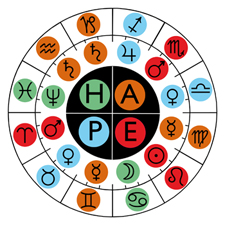 The title of this section is a quote from André Barbault from his book The Astrological Universe of the Four Elements published in 1992 by Éditions Traditionnelles. The incredible author of this pensum, hyper-aware of the flaw in internal logic constituted by the flagrant contradictions between the Elemental qualities of the Planets and those of the Signs they are supposed to govern, has decided to tackle this thorny problem head-on, for lack of being able to solve it thanks to the abstract subtleties of the Spirit.
The title of this section is a quote from André Barbault from his book The Astrological Universe of the Four Elements published in 1992 by Éditions Traditionnelles. The incredible author of this pensum, hyper-aware of the flaw in internal logic constituted by the flagrant contradictions between the Elemental qualities of the Planets and those of the Signs they are supposed to govern, has decided to tackle this thorny problem head-on, for lack of being able to solve it thanks to the abstract subtleties of the Spirit.
Following the atrabilar and unilateral decision of this astrologer who passes for a genius of this knowledge and who is only a small opportunistic irrational conservative, from now on, I quote him, “Each sign is endowed with the Element of the ruling planet. Thus, the Fire reigns in the marsian signs of Aries and Scorpio, as in the solar sign of Leo; the Earth in the mercurian signs of Gemini and Virgo, as well as in the saturnian signs of Capricorn and Aquarius; Air in the venusian signs of Taurus and Libra, as well as in the jupiterian sign of Sagittarius; and Water in the lunar sign of Cancer and the neptunian sign of Pisces. It is the planetarism that we find here, extended in a zodiacal reconstruction, and it is this which must serve as a reference for our interpretations of the temperamental type.”
We will notice the formidable logic and the perfect coherence (exclusively internal) of André Barbault (see figure above): all the Signs except Pisces (why him?) inherit the Element of their planet “Ruler” traditional (before the discovery of the trans-saturnians). The “Master” Traditional Pisces being Jupiter, Pisces should have been an Air Sign. But André Barbault decided otherwise, no doubt because it bothered him that there was only one Water Sign, Cancer, which prompted him to arbitrarily introduce a single non-traditional Planet, Neptune. As for the colors, it’s a lot of fun: everything finally seems coherent, and too bad if this neo-zodiac is made up of Elements in dissimilar quantities: 3 Fire Signs (Aries, Leo & Scorpio), 3 Air Signs (Taurus, Libra & Sagittarius), 4 Earth Signs (Gemini, Virgo, Capricorn & Aquarius) and 2 Water Signs (Cancer and Pisces), and if it loses its beautiful layout in grand trines linking the Signs of same Element between them.
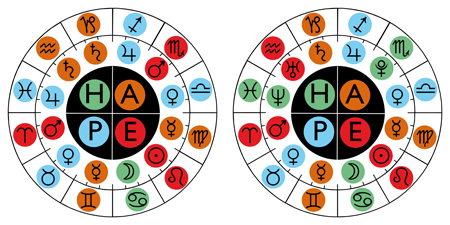 In short, it’s nonsense, all the more so since the same Barbault continues, despite this diktat, to use neo-planetary mastery (Neptune for Pisces, which he arbitrarily introduced into the traditional arrangement, Pluto on Scorpio and Uranus on Aquarius, which he excluded for who knows what (un)reasons) in his practice of astrology. If Barbault had been at the end of his logic according to which the Signs must inherit the Element of their Master Planet and if he had made his theory and his practice coherent, he should have proposed two possibilities of a neo-zodiac of the Elements, represented by the diagrams opposite. The one on the left represents the Elemental qualities of the Signs while retaining traditional planetary Masteries. We would then have 4 Air Signs, 4 Earth Signs, 3 Fire Signs and only one Water Sign. A neo-zodiac that is not very aquatic, but nevertheless coherent from the point of view of internal logic. The one on the right represents the Elemental qualities of the Signs by adopting the neo-planetary Masteries. Its advantage is to restore the zodiacal balance between the Elements (3 Fire Signs, 3 Earth Signs, 3 Air Signs and 3 Water Signs), but on the grand trine side it’s still just as bad: only the Water Signs have the right.
In short, it’s nonsense, all the more so since the same Barbault continues, despite this diktat, to use neo-planetary mastery (Neptune for Pisces, which he arbitrarily introduced into the traditional arrangement, Pluto on Scorpio and Uranus on Aquarius, which he excluded for who knows what (un)reasons) in his practice of astrology. If Barbault had been at the end of his logic according to which the Signs must inherit the Element of their Master Planet and if he had made his theory and his practice coherent, he should have proposed two possibilities of a neo-zodiac of the Elements, represented by the diagrams opposite. The one on the left represents the Elemental qualities of the Signs while retaining traditional planetary Masteries. We would then have 4 Air Signs, 4 Earth Signs, 3 Fire Signs and only one Water Sign. A neo-zodiac that is not very aquatic, but nevertheless coherent from the point of view of internal logic. The one on the right represents the Elemental qualities of the Signs by adopting the neo-planetary Masteries. Its advantage is to restore the zodiacal balance between the Elements (3 Fire Signs, 3 Earth Signs, 3 Air Signs and 3 Water Signs), but on the grand trine side it’s still just as bad: only the Water Signs have the right.
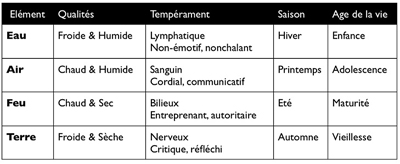 Whatever method is used to attempt to make the Elemental qualities of the Signs and their Master Planets coherent, it will be noted that this does not alter the aberrant, incoherent and contradictory attribution of Fire, Earth, Air and from Water to the Seasons and to the quadrants of the local sphere. This basic defect of the doctrine is so embarrassing that Barbault is careful not to mention it in his 325-page book devoted to the four Elements, while he quotes abundantly Hippocrates and Ptolemy who, for their part, paid no attention to them in their writings (or more precisely, in the case of Hippocrates, the writings attributed to him). The table opposite recalls the reality of this disturbing fact for Barbault.
Whatever method is used to attempt to make the Elemental qualities of the Signs and their Master Planets coherent, it will be noted that this does not alter the aberrant, incoherent and contradictory attribution of Fire, Earth, Air and from Water to the Seasons and to the quadrants of the local sphere. This basic defect of the doctrine is so embarrassing that Barbault is careful not to mention it in his 325-page book devoted to the four Elements, while he quotes abundantly Hippocrates and Ptolemy who, for their part, paid no attention to them in their writings (or more precisely, in the case of Hippocrates, the writings attributed to him). The table opposite recalls the reality of this disturbing fact for Barbault.
André Barbault considers himself a genius of astrology who has produced a prodigious body of work. As he writes himself on the dedicated site, “However, I would have been careful not to make a selective reminder of it if — my Uranus in 1 is both Ascendant lord and conjunct with it, being moreover at the upper point of a kite figure, placing it to the fullness of all of its planetary cycles — my language had not expressed a particular verb which differentiates me from the whole of astrological production, the reader being assured, with me, of not falling into repetition, even less in the banality, sure that it is even to encounter something new.”
And too bad if to make something new you have to come up with nonsense.

If Aquarius is an Earth Sign since its traditional Master Planet Saturn is also, why does Barbault still make Uranus, Planet of Fire (angular in its Chart to the Ascendant), the Mistress of this Sign, in contradiction to his own assertions? Because Barbault tells nonsense. Unless he considers that Uranus is a Planet of Earth, but that he does not say anywhere, no more than he mentions. Admire the rigor…
In André Barbault’s defense, let us recognize that he is one of the rare traditional astrologers to have been so embarrassed by the total inconsistency of the doctrine of the planetary Masteries within the framework of that of the four Elements, and to have drawn the conclusion that so something had to be changed (even if the solution it imposes does not fundamentally change anything) to get out of this irrational jumble. Most astrologers live with the glaring inconsistencies of this bad theory without seeming to bother them in the least.
A good theory must indeed describe, reflect and explain as faithfully as possible the various facets and structures of the observed reality. The Elemental zodiac is unable to do so. As such, it is to be placed on a shelf in the museum of knowledge, along with quantities of other bygone beliefs and obsolete doctrines.
The fact remains that whatever the eras and civilizations, Man has always represented the world around him through symbolic integers: the Unique (such as the absolute of a God from whom everything proceeds and of whom the Whole is only a reflection), the Duo-Duel (the various forms of thought based on conflict or the complementarity of antagonisms, such as Cathar philosophy or Taoism)… or duality wave-particle of quantum physics according to which electrons, atoms, molecules or even photons are both small bodies and waves, the Trine (7) (cf. the Brahma-Shiva-Vishnu triumvirate of the Hinduism or the Catholic Holy Trinity)… or the three states of matter (solid, liquid, gaseous), etc.
And in this area of the first natural numbers, the Quaternary also figures prominently. From Empedocles to Hippocrates, from Hippocrates to Socrates, examples abound: the quaternary is attractive to the human spirit. And the Elements or Temperaments are undoubtedly symbols, images or representations of this “quaternity instinct” which seems consubstantial with the intellectual constructions of Man through centuries and civilizations… Thus, the holy grail currently pursued by physicists is the one that would make it possible to understand the link between four elementary interactions responsible for all physical phenomena observed in the Universe, which are manifested by the fundamental forces of strong nuclear interaction, electromagnetic interaction, weak nuclear interaction and gravitation.
The great psychologist C. G. Jung brought up to date the old quaternary structure through its typological system allowing to describe the psychic functioning through the categories “Sensing-Feeling-Thinking-Intuition”. Simple modernist dressing of the Hippocratic Temperaments? Nothing is less sure. Even though there are relative analogies, the type “Sensation” as described by Jung should not be confused with the “Choleric”, the “Feeling” with the “Sanguine”, the “Thought” with the “Melancholic” and the “Intuition” with the “Phlegmatic”. The quaternaries follow each other and do not necessarily resemble each other, except at the structural level.
In itself, a quaternary is an empty container (or an archetype in Jungian parlance). It’s just a numerical structure, maybe esoteric, apparently essential to our intellectual constructions, which we fill with variable content depending on the place, the time, the evolution of our knowledge and the fields of application. Thus Jung brought new contents to the empty structure of the quaternary that Empedocles, Hippocrates and Aristotle had “filled” of Fire-Earth-Air-Water and Cold-Hot-Dry-Humid.
Like Aristotle, Jung was not satisfied with an overly simple quaternary: he broke it down into binary structures (Extraversion-Introversion), which more or less refers to the binaries of the astrological tradition (Signs alternately “male” and “female” (8)). Later and in the same vein, the astrologer Jean Carteret and the philosopher Raymond Abéllio also made extensive use of the dialectized quaternary in binaries to construct their esoteric theories.
One can wonder about the reason for this obsession with the quaternary in human thought. Is the 4 an inescapable esoteric structure, inherent in Nature, or is it only a projection of the spirit?
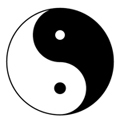 In fact, even the Chinese are no exception: despite their five elements or parallel to them, they could not help developing a binary thought that refers to the quaternary: I mean Yin and Yang, broken down into Young Yin and Old Yin, Young Yang and Old Yang in the Tao-Tö-King. By adopting the sign ‘+’ for Yang (= “masculine”) and the ‘−’ for Yin (= “feminine”), the sign ‘+’ for the Young and the sign ‘−’ for the Old, we thus arrives, for example, at the following quaternary structure: Yang young = + +; Yang old = + −; Yin young = − + and Yin old = − −.
In fact, even the Chinese are no exception: despite their five elements or parallel to them, they could not help developing a binary thought that refers to the quaternary: I mean Yin and Yang, broken down into Young Yin and Old Yin, Young Yang and Old Yang in the Tao-Tö-King. By adopting the sign ‘+’ for Yang (= “masculine”) and the ‘−’ for Yin (= “feminine”), the sign ‘+’ for the Young and the sign ‘−’ for the Old, we thus arrives, for example, at the following quaternary structure: Yang young = + +; Yang old = + −; Yin young = − + and Yin old = − −.
The same abstract structure ‘+ −’ can be used for the Elements: Hot (C) brings a ‘+’ of temperature and Cold (C) a ‘−’. The Wet (H) brings a ‘+’ of fertility and the Dry (S) a ‘−’. Hence the following abstract structure: Air (Hot and humid) = + +; Fire (Hot and Dry) = + −; Water (Cold and Wet) = − + and Earth (Cold and Dry) = − −. This structured progression (from ‘+ +’ to ‘− −’) undermines the structure of the Elemental Triplicities based on a succession of Fire-Earth-Air-Water, but also the Elemental analogies of the Seasons (progression Air-Fire-Earth- Water).
 But back to Yin/Yang: Yang is analogous to Jung’s extroversion and the Day Signs (from Aries to Virgo inclusive, the day dominates in spring and summer) of traditional astrology, and Yin to introversion and nocturnal signs (from Libra to Pisces included, the night dominates in duration in autumn and winter). The youth of Yang or Yin would then be analogous to the dominant increase in duration (‘+’) of day (‘+’) or night (‘−’), and their old age to decrease (‘−’). Which gives us a new quaternary structure: Spring (increasing day) = + +; Summer (decreasing day) = + −; Autumn (increasing night) = − + and Winter (decreasing night) = − −… which brings us back to the photoperiodic zodiac based on the diurnal-nocturnal alternation.
But back to Yin/Yang: Yang is analogous to Jung’s extroversion and the Day Signs (from Aries to Virgo inclusive, the day dominates in spring and summer) of traditional astrology, and Yin to introversion and nocturnal signs (from Libra to Pisces included, the night dominates in duration in autumn and winter). The youth of Yang or Yin would then be analogous to the dominant increase in duration (‘+’) of day (‘+’) or night (‘−’), and their old age to decrease (‘−’). Which gives us a new quaternary structure: Spring (increasing day) = + +; Summer (decreasing day) = + −; Autumn (increasing night) = − + and Winter (decreasing night) = − −… which brings us back to the photoperiodic zodiac based on the diurnal-nocturnal alternation.
All this does not mean that ‘++’ = Air = Young = Spring. If it were as simple as that, it would suffice to dress up each of the three musketeers of Alexandre Dumas (who were four, as everyone knows) ‘+’ and ‘−’ to make this fake trio a quaternary meaning of thought. In these matters, it is advisable to be excessively careful, and above all not to mix everything under the pretext of noting formal analogies: all the objects grouped by four are not structured, homogeneous and significant quaternaries… and all the structured quaternaries, homogeneous and signifiers are not identical in terms of their content(s).
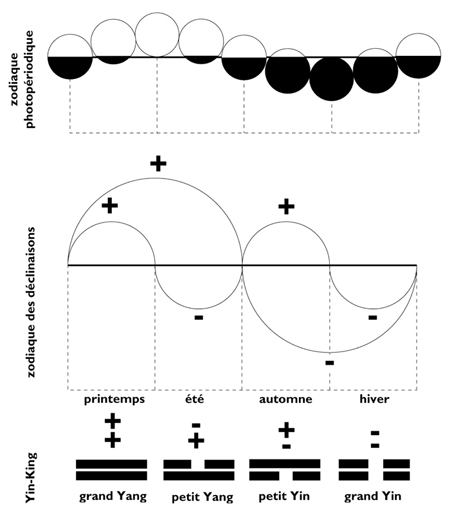 The quaternary of Yin and Yang and that of the conditionalist zodiac can be combined to arrive at an original symbolic figure like the one opposite. But independently of the Tao, the quaternary exists in itself in the photoperiodic zodiac (9), so designated because it is based on the variations of diurnal or nocturnal presence, that is to say on the periodicities of light. and its absence, but it is not that of the Elements nor that of the Tao. In fact, we distinguish:
The quaternary of Yin and Yang and that of the conditionalist zodiac can be combined to arrive at an original symbolic figure like the one opposite. But independently of the Tao, the quaternary exists in itself in the photoperiodic zodiac (9), so designated because it is based on the variations of diurnal or nocturnal presence, that is to say on the periodicities of light. and its absence, but it is not that of the Elements nor that of the Tao. In fact, we distinguish:
▶ The 4 equinoctial signs (Pisces, Aries, Virgo & Libra) who have in common the Sense of Opposites: each in their own way they clearly perceive one thing (diurnal or day) and its opposite (nocturnal or night). This objective astronomical phenomenon sensitizes the individuals concerned by these Signs to the problems of choice. Positive, quick picks for the lively excited of the Aries, slow and systematic in the Virgo slowly excited, choice by subtle avoidances for the lively inhibited Libra, and finally choice by thick indifference with regard to the non-chosen element in the slow inhibited of the Pisces:
▶ The 4 Solstice Signs (Gemini, Cancer, Sagittarius & Capricorn) who have in common the Sense of Syntheses: each in their own way they perceive a pole (diurnal or nocturnal) clearly dominant and a pole (diurnal or nocturnal) clearly dominated. This phenomenon sensitizes the individuals concerned by these Signs to the problems of synthesis or generalization;
▶ The 4 Intermediate Signs (Taurus, Leo, Scorpio & Aquarius) who have in common the Dosage direction: each in their own way they perceive a pole (diurnal or nocturnal) relatively dominant and a pole (diurnal or nocturnal) relatively dominated. This phenomenon sensitizes the individuals concerned by these Signs to the problems of dosage, balance of power or combination.
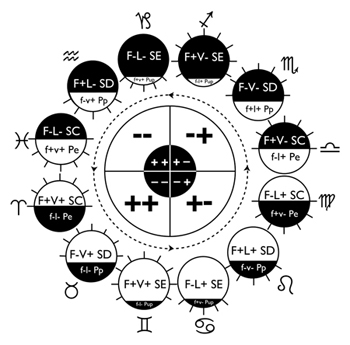 Any Season or Sign is characterized by the ratio of the durations between the diurnal arc and the nocturnal arc of the Sun (for the Seasons) and of the planets (for the Signs), as well as by the increasing or decreasing character of these arcs.
Any Season or Sign is characterized by the ratio of the durations between the diurnal arc and the nocturnal arc of the Sun (for the Seasons) and of the planets (for the Signs), as well as by the increasing or decreasing character of these arcs.
The dominant diurnal arc in duration (Spring-Summer) is an excitation factor (code ‘+’: openness, positive responses to external stimuli). The dominant nocturnal arc in duration (Autumn-Winter) is an inhibition factor (code ‘−’: closure, negative responses to external stimuli). The increasing and dominant arc in duration (diurnal in Spring, nocturnal in Autumn) is a source of sharp, rapid reactions (code ‘+’), while the decreasing and dominant arc in duration (diurnal in Summer, nocturnal in Winter) is a source of slow, progressive reactions (code ‘−’).
Hence the following quaternary, illustrating four “kinds” seasonal:
▶ the spring is a lively exciter (‘+ +’) fast, improviser, quick start, enthusiastic.
▶ the summer is a slow excited (code ‘+ −’) with progressive starts, obstinate, persevering, obstinate in his progress.
▶ autumn is a lively inhibited (code ‘− +’, he has the art of immediate dodging and flexible defensive tactics.
▶ winter is a slow inhibitor (code ‘−’), with systematic closing reactions and immutable defense systems.
Is it possible to establish a formal homology between the Hippocratic Temperaments, the 4 Symbolic Elements and these four “kinds” deduced from human responses to variations in diurnal-nocturnal relationships? A priori, between seasonal quaternaries, we should look alike and be able to get along. Let’s try…
▶ The lively excited of spring is quite similar to Sanguin-Air, described by A. Barbault as “an expansive who lives on mobility… exchanges, contacts with the environment, to which he adapts and assimilates spontaneously”.
▶ The slow excited summer has a very vague family resemblance to Bilieux-Feu, characterized among other things by the same author by “its dominating action, (its) conquering power”. This analogy ends there: the slow excited has nothing of the tumultuous and exasperated nature of the Fire temperament.
▶ The lively inhibited of autumn does not correspond to any temperament or Element, and especially not to the Earth Element. By the mobility and the speed of his reactions, he is a bit like the Sanguin-Air, that’s all.
▶ The slow inhibited in some ways resembles the Melancholic-Earth, in the sense that its systematic and persistent refusal mechanisms favor “petrification, mineralization, fossilization… stripping, detachment” (description of “Earth Temperament” by A. Barbault).
As we can see, none of the “kinds” humans defined by the zodiacal conditionalist quaternary do not correspond exactly to the Temperaments induced by the 4 Elements. Even worse: the Phlegmatic-Water has no affinity with these different “kinds” excited or inhibited, except perhaps, and from afar, with the slow inhibited, with whom he can share a great indifference vis-à-vis the solicitations of the outside world, as well as a certain lack punch…
▶ (1) Read about it Traité pratique d’astrologie and De la psychanalyse à l’astrologie, A. Barbault, Ed. Threshold.
▶ (2) L’astrologie de la transformation, D. Rudhyar, Ed. of the rock.
▶ (3) He has just published Les quatre éléments to Eds. Traditional.
▶ (4) See The Fil d’ARIANA No. 1, article on astrological twins.
▶ (5) While the planetary meanings are borrowed from the gods of the Greek pantheon, to whom the Hellenes never dreamed of systematically attributing Elemental qualities!
▶ (6) Dictionnaire de la mythologie grecque et romaine, Ed. Larousse.
▶ (7) One/two/multiple: it is precisely these esoteric relationships between the Numbers that describe and define, among other things, the system R.E.T. (Representation-Existence-Transcendence) discovered by J.-P. Nicola.
▶ (8) Except that, in the binary-quaternary interactions of Elemental astrology, the Fire and Air Signs can only be “masculine”, and those of Earth and Water “feminine”. In this sense, the binary only confirms the quaternary: it is superfluous. For Jung, on the contrary, Sensation, Feeling, Thought or Intuition can be either introverted or extroverted: for him, the grafting of the binary onto the quaternary profoundly modifies the conditions of expression of the quaternary.
▶ (9) See p. 149 to 173 of Manuel d’astrologie universelle.
Article published in issue No. 3 of the Fil d’ARIANA (April 1995) and in L’Astrologue (2nd quarter 1995).
▶ Comparative reviews of European and Western forms of astrology
▶ André Barbault et le conditionalisme
▶ André Barbault, l’astro-symbolisme et le dernier âge d’or de l’astrologie
▶ Une critique inepte du conditionalisme par André Barbault
▶ Le taijitu dans le système solaire
▶ Critique of the doctrine of planetary Rulerships
▶ Astrologie et astrologies : écoles, courants et chapelles
▶ The world according to Claudius Ptolemy, astronomer-astrologer and lighthouse of Alexandria

Les significations planétaires
par
620 pages. Illustrations en couleur.
La décision de ne traiter dans ce livre que des significations planétaires ne repose pas sur une sous-estimation du rôle des Signes du zodiaque et des Maisons. Le traditionnel trio Planètes-Zodiaque-Maisons est en effet l’expression d’une structure qui classe ces trois plans selon leur ordre de préséance et dans ce triptyque hiérarchisé, les Planètes occupent le premier rang.
La première partie de ce livre rassemble donc, sous une forme abondamment illustrée de schémas pédagogiques et tableaux explicatifs, une édition originale revue, augmentée et actualisée des textes consacrés aux significations planétaires telles qu’elles ont été définies par l’astrologie conditionaliste et une présentation détaillée des méthodes de hiérarchisation planétaire et d’interprétation accompagnées de nombreux exemples concrets illustrés par des Thèmes de célébrités.
La deuxième partie est consacrée, d’une part à une présentation critique des fondements traditionnels des significations planétaires, d’autre part à une présentation des rapports entre signaux et symboles, astrologie et psychologie. Enfin, la troisième partie présente brièvement les racines astrométriques des significations planétaires… et propose une voie de sortie de l’astrologie pour accéder à une plus vaste dimension noologique et spirituelle qui la prolonge et la contient.
Téléchargez-le dès maintenant dans notre boutique

Pluton planète naine : une erreur géante
par
117 pages. Illustrations en couleur.
Pluton ne fait plus partie des planètes majeures de notre système solaire : telle est la décision prise par une infime minorité d’astronomes lors de l’Assemblée Générale de l’Union Astronomique Internationale qui s’est tenue à Prague en août 2006. Elle est reléguée au rang de “planète naine”, au même titre que les nombreux astres découverts au-delà de son orbite.
Ce livre récapitule et analyse en détail le pourquoi et le comment de cette incroyable et irrationnelle décision contestée par de très nombreux astronomes de premier plan. Quelles sont les effets de cette “nanification” de Pluton sur son statut astrologique ? Faut-il remettre en question son influence et ses significations astro-psychologiques qui semblaient avérées depuis sa découverte en 1930 ? Les “plutoniens” ont-ils cessé d’exister depuis cette décision charlatanesque ? Ce livre pose également le problème des astres transplutoniens nouvellement découverts. Quel statut astrologique et quelles influences et significations précises leur accorder ?
Enfin, cet ouvrage propose une vision unitaire du système solaire qui démontre, chiffes et arguments rationnels à l’appui, que Pluton en est toujours un élément essentiel, ce qui est loin d’être le cas pour les autres astres au-delà de son orbite. Après avoir lu ce livre, vous saurez quoi répondre à ceux qui pensent avoir trouvé, avec l’exclusion de Pluton du cortège planétaire traditionnel, un nouvel argument contre l’astrologie !
Téléchargez-le dès maintenant dans notre boutique